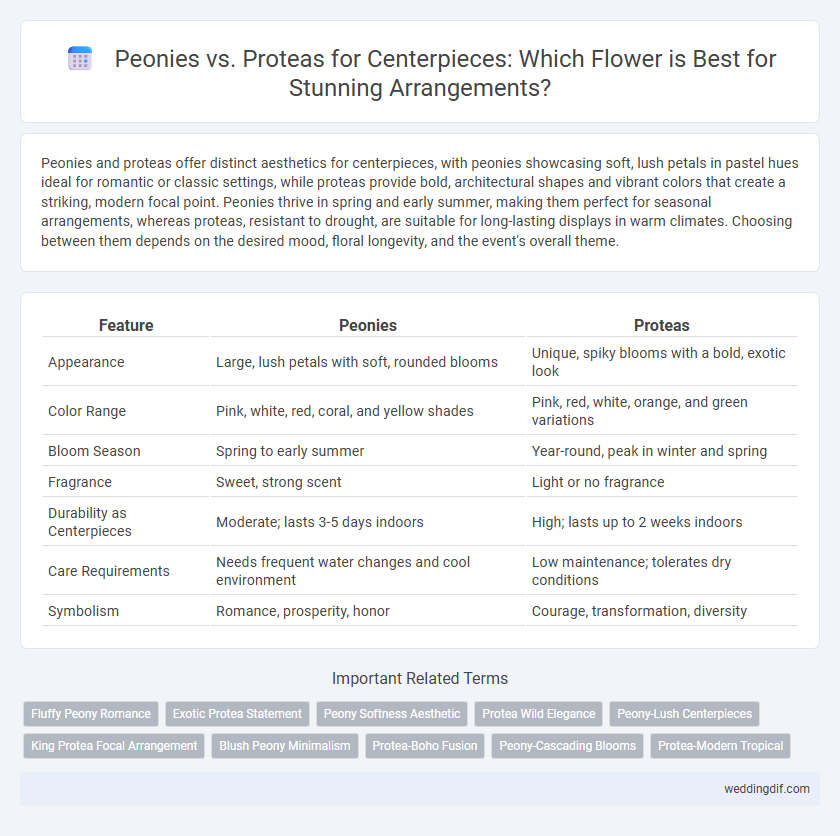Peonies and proteas offer distinct aesthetics for centerpieces, with peonies showcasing soft, lush petals in pastel hues ideal for romantic or classic settings, while proteas provide bold, architectural shapes and vibrant colors that create a striking, modern focal point. Peonies thrive in spring and early summer, making them perfect for seasonal arrangements, whereas proteas, resistant to drought, are suitable for long-lasting displays in warm climates. Choosing between them depends on the desired mood, floral longevity, and the event's overall theme.
Table of Comparison
| Feature | Peonies | Proteas |
|---|---|---|
| Appearance | Large, lush petals with soft, rounded blooms | Unique, spiky blooms with a bold, exotic look |
| Color Range | Pink, white, red, coral, and yellow shades | Pink, red, white, orange, and green variations |
| Bloom Season | Spring to early summer | Year-round, peak in winter and spring |
| Fragrance | Sweet, strong scent | Light or no fragrance |
| Durability as Centerpieces | Moderate; lasts 3-5 days indoors | High; lasts up to 2 weeks indoors |
| Care Requirements | Needs frequent water changes and cool environment | Low maintenance; tolerates dry conditions |
| Symbolism | Romance, prosperity, honor | Courage, transformation, diversity |
Peonies vs Proteas: A Centerpiece Showdown
Peonies boast lush, ruffled petals and a soft fragrance, making them a classic choice for romantic centerpieces, while proteas offer a bold, sculptural appearance with their unique spiky blooms and long vase life. Peonies thrive in spring and early summer, providing pastel hues, whereas proteas bring vibrant, exotic colors and a modern aesthetic year-round. Choosing between peonies and proteas depends on the desired centerpiece style--delicate elegance or striking, contemporary flair.
Color Palette Comparison: Peonies and Proteas
Peonies offer a soft, romantic color palette ranging from blush pinks and creamy whites to deep reds, ideal for classic or elegant centerpieces. Proteas present bold, exotic hues including vibrant oranges, rich reds, and unique greens, perfect for modern or tropical-themed arrangements. Combining these contrasting palettes can create dynamic visual interest through a blend of delicate pastels and striking, vivid tones.
Texture and Shape: Creating Visual Interest
Peonies offer lush, rounded blooms with soft, layered petals that create a full, romantic texture ideal for classic centerpieces. Proteas stand out with their spiky, geometric shapes and bold textures, lending a modern and sculptural feel to arrangements. Combining peonies' softness with proteas' architectural forms enhances visual interest through contrasting textures and dynamic shapes.
Seasonal Availability of Peonies vs Proteas
Peonies bloom primarily in late spring to early summer, offering a limited seasonal window from April to June, making them ideal for weddings and events during these months. Proteas are more versatile, with several species blooming from late winter through late summer, allowing for extended availability and creative flexibility in centerpieces. Choosing between peonies and proteas depends largely on the timing of the event and desired floral longevity.
Cost Considerations for Wedding Centerpieces
Peonies generally come at a higher price point due to their seasonal availability and delicate nature, making them a premium choice for wedding centerpieces. Proteas, native to South Africa, tend to be more cost-effective year-round because of their durability and longer shelf life. Choosing proteas can significantly reduce floral expenses while still offering a unique, bold aesthetic for wedding tables.
Matching Peonies and Proteas with Wedding Themes
Peonies, with their lush, romantic blooms, perfectly complement classic and garden-themed weddings, adding softness and elegance to centerpieces. Proteas, featuring bold, architectural shapes and unique textures, suit modern, rustic, or bohemian themes, offering striking visual contrast and a touch of exotic flair. Combining peonies and proteas in centerpieces creates a dynamic balance, enhancing diverse wedding aesthetics from vintage charm to contemporary sophistication.
Scent Factor: Fragrance in Centerpiece Selection
Peonies offer a delicate, sweet fragrance that enhances ambiance and adds a romantic touch to centerpieces, making them ideal for intimate settings and weddings. Proteas, in contrast, have little to no scent but provide a bold visual statement with their unique, exotic appearance, often favored for modern or minimalist designs. Choosing between peonies and proteas for centerpieces depends on whether a fragrant presence or striking visual impact is the priority.
Longevity and Vase Life: Which Lasts Longer?
Peonies typically have a vase life of 5 to 7 days, offering lush blooms that gradually fade but maintain their elegance. Proteas, known for their durability, can last up to 2 to 3 weeks in a vase, making them ideal for long-lasting centerpieces. Their robust structure and slower water absorption contribute to extended freshness compared to the more delicate peony petals.
Styling Tips: Arranging Peonies and Proteas
Peonies offer lush, full blooms that create a soft, romantic centerpiece, best styled in loose, rounded bouquets with complementary greenery like eucalyptus or ferns to enhance their delicate petals. Proteas bring a bold, architectural statement with their spiky textures and vibrant colors, ideal for modern arrangements combined with succulents or dried elements to emphasize their exotic appeal. Mixing peonies and proteas requires balancing soft, voluminous flowers with striking, structured elements for a visually dynamic and texturally rich centerpiece.
Sustainability: Eco-Friendliness of Peonies vs Proteas
Peonies, often grown in temperate climates, typically require seasonal cultivation with moderate water use and organic farming practices that minimize pesticide reliance, enhancing their eco-friendliness. Proteas, native to South Africa's fynbos region, are naturally drought-tolerant and thrive with low irrigation and minimal chemical inputs, making them highly sustainable for environmentally conscious floral arrangements. Choosing proteas for centerpieces supports biodiversity and water conservation, while peonies offer a carbon footprint advantage when sourced locally during their short blooming season.
Peonies vs Proteas for centerpieces Infographic

 weddingdif.com
weddingdif.com